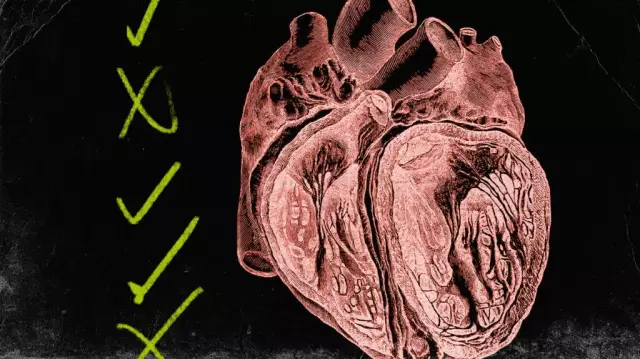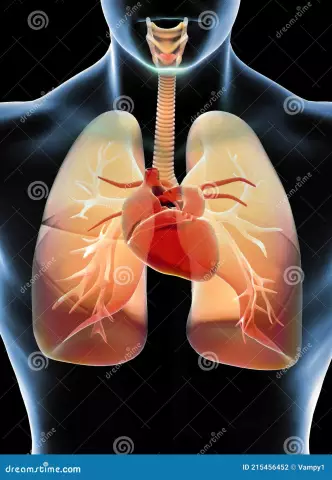- Author Curtis Blomfield [email protected].
- Public 2023-12-16 20:44.
- Last modified 2025-06-01 06:18.
Often we hear the expression "cardiopulmonary insufficiency", but few can definitely say what this pathology is. What kind of disease is this, what are its signs and causes - we will figure it out.
Cardiopulmonary failure - what is it?

In modern medicine, cardiopulmonary insufficiency is understood as a condition in which heart failure, that is, the inability of the heart to provide normal blood supply in the body, is combined with pulmonary, which occurs due to excessive blood pressure in the vessels of the lungs, where gas exchange occurs. All this leads to a decrease in the level of oxygen in the blood.
In practice, pulmonary insufficiency often develops first, cardiac symptoms join it after a while. Strictly speaking, this symptom complex can be observed both in many diseases of the cardiovascular system and in diseases of the lungs. In its course, the pathology can manifest itself in an acute form, when the symptoms increase in a short time period, and may also have a chronic variety, when the deteriorationstate occurs over several years or even decades.
Causes of acute cardiopulmonary failure

Acute pulmonary insufficiency is a complication that occurs in some conditions that threaten the life of the patient. This requires urgent medical intervention. As a rule, it can develop under the following conditions:
- as a result of thrombosis or spasm of the pulmonary artery;
- for thromboembolism;
- with pneumo- or hydrotorex;
- with exacerbation of bronchial asthma, status asthmaticus.
However, heart pathologies can also cause an increase in pressure in the pulmonary artery. Most often, this occurs with sudden mitral valve insufficiency. Also, the cause of the development of pulmonary insufficiency can be pulmonary valve insufficiency, acute heart attack, myocarditis, heart defects in the stage of decompensation, cardiomyopathy. At the same time, the cavity of the left ventricle expands, and the contraction of its wall is no longer able to push the entire volume of blood into the lumen of the vessel. Some of it stagnates and increases the pressure in the pulmonary veins. As the right ventricle continues to pump blood to its full capacity, pressure continues to rise, which can lead to pulmonary edema or cardiac asthma.
Causes of chronic cardiopulmonary failure

Chronic pulmonary insufficiency, unlike the acute form, grows slowly. Processthe growth of pathological changes goes on for several years. In this case, the development of hypertension in the pulmonary vessels occurs due to the following pathologies:
- hereditary idiopathic hypertension;
- atherosclerosis;
- pulmonary artery insufficiency, which may be caused by endarteritis or repeated embolism of small branches;
- chronic lung diseases - emphysema, pleurisy, pneumosclerosis, obstructive bronchitis;
- slowly progressive congenital heart disease;
- acquired valvular disorders.
Pulmonary failure: severity levels
Due to the fact that the chronic form of this disease is characterized by a slow and often almost imperceptible increase in pathological symptoms, four degrees of severity of the disease are determined:
- I degree - there are no signs of the disease, with the usual physical activity, there are no manifestations of the disease, with an increase in the load, a slight shortness of breath appears.
- II degree - no symptoms at rest, but shortness of breath and palpitations appear with habitual physical activity.
- III degree - symptoms of insufficiency appear with minimal physical exertion, but are absent at rest.
- IV degree - a person cannot exercise minimal physical activity, signs of the disease appear at rest.
Acute attack of pulmonary insufficiency can develop according to one of two options - right and left ventricular failure. Left ventricular failure canmanifest as pulmonary edema or cardiac asthma.

Cardiac asthma
This is a pulmonary insufficiency, the symptoms of which increase gradually. In the early stages, it is manifested by shortness of breath, which appears first after physical exertion, over time it intensifies, appearing even at rest. With shortness of breath, the act of inhalation (inspiratory character) is difficult. In the future, it is replaced by asthma attacks, most often occurring during sleep. For this stage, a forced posture is indicative - a high headboard, during attacks the patient is forced to sit down, lowering his legs from the bed and leaning on his hands, in addition to shortness of breath, palpitations, sweating, and fear of death appear. The cough in cardiac asthma is dry, with scanty expectoration. The skin is pale, pronounced cyanosis of the nasolabial triangle, fingers. The pulse is irregular, weak, the pressure is reduced.
Let's consider what features cardiac and bronchial asthma have:
| Cardiac | Bronchial | |
| Breathing | Noisy, bubbling, well audible at a distance | Whistling, dry |
| Type of breathlessness | Inspiratory (difficulty inhaling) | Expiratory (difficulty exhaling) |
| Sputum | Scanty, with pulmonary edema - pink foam | A lot of clear sputum that is difficult to separate |
| Auscultation | Moist rales | Dry, wheezing, weak breathing |
| Drug action | The use of diuretics brings relief | Worse with diuretics |
Pulmonary edema

Acute lung failure can be complicated by the development of pulmonary edema. This is the release of a significant amount of blood into the lung tissue. The attack develops suddenly, regardless of the time of day. The beginning is characterized by a sharp suffocation, while there is a rapid deterioration in the patient's condition:
- shortness of breath increases, the patient does not have enough air, there is cyanosis of the skin of the face and extremities, cold sweat;
- consciousness is disturbed - it can be both motor excitement and stupor up to complete loss of consciousness;
- breath noisy, bubbling, pink foam stands out;
- if the attack occurred on the background of myocardial infarction or myocarditis, cardiogenic shock may develop.
Right ventricular failure

Can also occur as a complication of myocardial infarction or myocarditis. Its manifestations, in addition to shortness of breath and increasing suffocation, are:
- cyanosis of the face and fingers;
- clearly visible, especially on inspiration, swollen jugular veins;
- swelling of the legs, face, abdominal wall up to ascites;
- increaseliver, there is a pulsation in the epigastrium.
Chronic cardiopulmonary failure
Due to the fact that the chronic form of this pathology develops over many years, its clinical manifestations are less pronounced. Since the disease is most often based on the pathology of the respiratory system, it manifests itself primarily in shortness of breath. It may be accompanied by the following symptoms:
- chest pain;
- arrhythmia;
- tachycardia;
- cyanosis;
- swelling on the legs;
- swollen neck veins;
- encephalopathy.
As the disease progresses, the symptoms begin to intensify, and if at the beginning they appeared after certain loads, then in the final stages (in the stage of decompensation) this happens completely.
Cardiopulmonary failure treatment
The development of acute malnutrition usually requires prompt and professional intervention. As a rule, treatment is carried out in a hospital, and more often in an intensive care unit. If the attack has developed at home, you need to deliver the person to a medical facility as soon as possible. Therapy of the chronic form of the disease is an integrated approach to the treatment of the disease. This is not only a medical correction, but also an optimization of the level of physical activity and nutrition. Drug therapy for this pathology consists in prescribing the following groups of drugs:
- beta blockers;
- diuretics;
- cardiac glycosides.

The treatment regimen and dosage in each individual case is determined by the doctor. Self-medication in such cases is unacceptable. In case of failure of conservative treatment, the problem is solved surgically.






